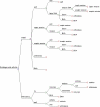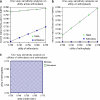Arthroplasty versus arthrodesis for end-stage ankle arthritis: decision analysis using Markov model
- PMID: 21858503
- PMCID: PMC3193966
- DOI: 10.1007/s00264-011-1336-1
Arthroplasty versus arthrodesis for end-stage ankle arthritis: decision analysis using Markov model
Abstract
Background: Total ankle arthroplasty and arthrodesis are the two mainstreams of treatment for end-stage ankle arthritis. This study was performed to determine which is a better choice for ankle arthritis, using a decision analysis and Markov model to reflect the repetitive nature of revision arthroplasty.
Methods: Based on current published evidence, a decision tree was constructed to compare the clinical outcomes of total ankle arthroplasty and arthrodesis, which contained the possible clinical events and the probabilities. Total ankle arthroplasty was subject to revision arthroplasty, and a Markov model was adopted for this branch to reflect this repetitive trait of the procedure. Arthrodesis could cause adjacent arthritis, and a conventional decision analysis model was adopted for this branch. Quality well-being index score was used for clinical outcome assessment, which was the utility in the decision tree. Sensitivity analysis was performed to test the stability of the decision tree and the threshold values.
Results: The model favoured total ankle arthroplasty over arthrodesis in terms of quality well-being index score. Sensitivity analysis showed that the model was considerably stable, unaffected by the changes in probabilities of failure after total ankle arthroplasty and adjacent arthritis after arthrodesis.
Conclusions: Based on current evidence, total ankle arthroplasty was found to be a better treatment than arthrodesis for ankle arthritis. Future development in the implant materials, improved understanding of ankle biomechanics, and surgical techniques will further enhance the clinical outcome of total ankle arthroplasty.
Figures



References
-
- Coester LM, Saltzman CL, Leupold J, Pontarelli W. Long-term results following ankle arthrodesis for post-traumatic arthritis. J Bone Joint Surg Am. 2001;83-A(2):219–228. - PubMed
-
- Bernstein J. Decision analysis. J Bone Joint Surg Am. 1997;79(9):1404–1414. - PubMed
-
- SooHoo NF, Kominski G. Cost-effectiveness analysis of total ankle arthroplasty. J Bone Joint Surg Am. 2004;86-A(11):2446–2455. - PubMed
-
- Hunink MG GP, Siegel JE, Weeks JC et al. (2001) Decision making in health and medicine: integrating evidence and values. Cambridge University Press
-
- Anderson T, Montgomery F, Carlsson A. Uncemented STAR total ankle prostheses. Three to eight-year follow-up of fifty-one consecutive ankles. J Bone Joint Surg Am. 2003;85-A(7):1321–1329. - PubMed
Publication types
MeSH terms
LinkOut - more resources
Full Text Sources
Medical

